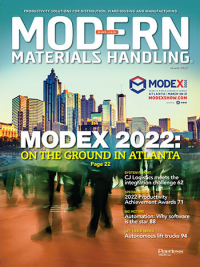Managing people and autonomous robots together
A fulfillment solution from Fetch Robotics and parent company Zebra Technologies looks to simultaneously manage human labor and mobile robots, in what’s shaping up as a trend aimed at helping labor-constrained operations.
With the rapid adoption of autonomous mobile robots (AMRs) in warehousing and other sectors, tasks like moving carts through a pick area, or sending completed orders and totes downstream to packing or to a conveyor system, are increasingly carried out by mobile robots, not people pushing carts.
At the same time, AMRs often work in close concert with human labor as part of the actual pick task, which has more vendors looking at workflows that leverage a combination of AMRs and warehouse associates.
While AMRs are effective at reducing much of the travel involved in conventional pick-to-cart methods, greater benefits can be had when the activities and timing of both robot and human resources are better coordinated, says James Lawton, vice president and general manager of robotics automation for Zebra Technologies.
Last year, Zebra, which is known for its rugged mobile devices, wearables like ring scanners, and other data collection and real-time location tracking technologies, acquired Fetch Robotics, a leading provider of AMR solutions. Lawton says AMRs alone can bring some benefits, but fuller optimization comes when an operation can coordinate robot and human resources to avoid unneeded wait times.
“We’ve seen through our market research and by going into facilities that are utilizing robots, that you would sometimes see the robots waiting around because there is no worker ready nearby to get started on a joint task. You can find the flip-side of that, too—people waiting for a mobile robot to show up in one of these robot-assisted, zone-based picking solutions. So, all that waiting adds up to waste, which could be eliminated,” Lawton says.
To address this need, last October, Fetch and Zebra announced a new fulfillment solution that consists of three new AMR models—FlexShelf, FlexShelf Guide and RollerTop Guide—and a new FetchCore fulfillment software package for order or batch picking.
Lawton says the software uses a combination of software Fetch had developed for AMR fleet management and drag-and-drop configuration of AMR processes, while its optimization layer for managing both people and robots draws on capabilities from Zebra’s Fulfillment Edge software package.
The result, says Lawton, is that the Fetch Fulfillment Solution can better manage and coordinate human and robot resources to reduce wait times, and allow the robots to do what they do best: direct workers through accurate picking and fulfillment activities in a relatively compact area of the warehouse, which eliminates much of the walking (and all of the cart pushing) typically involved in conventional pick-to-cart methods.
Zebra describes Fulfillment Edge as a “WMS accelerator” in that it ties into different warehouse management system (WMS) solutions to provide a user-friendly application for tasks like order picking, as well as business intelligence tools to gauge productivity. This capability allows an operation to scale up by adding more connected workers and conventional carts, should they want to go that route to meet demand during peak periods.
The optimization layer is used to simultaneously direct and optimize the tasks of robots and workers outfitted with rugged mobile devices or wearables.
“With this solution, a connected worker, or what some call an ‘instrumented’ worker, along with the robots, can be better coordinated, and in some scenarios, can both be redirected to the next best activity that achieves an optimized workflow overall,” Lawton says. “When you can manage and redirect both human and AMR resources together, rather than separately, we believe it results in greater productivity and throughput.”
The fulfillment solution from Fetch and Zebra is touted as offering up to a three-fold increase in productivity versus a traditional pick-to-cart scenario based on human labor and mobile device inputs, rather than stay in a tighter zone and have mobile robots come to them to guide them through a set of picks. Fetch continues to offer stand-alone AMR solutions and its industry partnerships with other vendors involved in warehouse optimization, including Lucas Systems.
Of course, other vendors are also addressing solutions that optimize the potential of both robots and people. Robotics vendors are talking more about software that extends beyond task assignment and routes for robots.
For example, inVia Robotics points out that its software has in some cases been deployed first for human-centered processes, to gain efficiencies there, before the robots are deployed. Additionally, major providers of WMS and warehouse execution systems are addressing workflows that combine human and robot resources.

Article Topics
AMR News & Resources
Autonomous mobile robots (AMRs) on a mission Automotive materials handling: The calm after the storm C-suite Interview with Paccurate’s James Malley: The golden age of supply chain technology Conveyco unveils All-Temp AMRs that can move between frozen, chilled and ambient warehouses Seegrid Unveils New, Greater Height and Heavier Payload Palion™ Lift CR1 Autonomous Lift Truck at MODEX 2024 Retail distribution closes in on the customer Research Report: 2024 Warehouse Outlook & Trends More AMRLatest in Materials Handling
Geek+ and System Teknik deploy PopPick solution for pharmacy group Med24.dk Beckhoff USA opens new office in Austin, Texas Manhattan Associates selects TeamViewer as partner for warehouse vision picking ASME Foundation wins grant for technical workforce development The (Not So) Secret Weapons: How Key Cabinets and Asset Management Lockers Are Changing Supply Chain Operations MODEX C-Suite Interview with Harold Vanasse: The perfect blend of automation and sustainability Consultant and industry leader John M. Hill passes on at age 86 More Materials HandlingAbout the Author
Subscribe to Materials Handling Magazine

Find out what the world's most innovative companies are doing to improve productivity in their plants and distribution centers.
Start your FREE subscription today.
April 2024 Modern Materials Handling

Latest Resources












